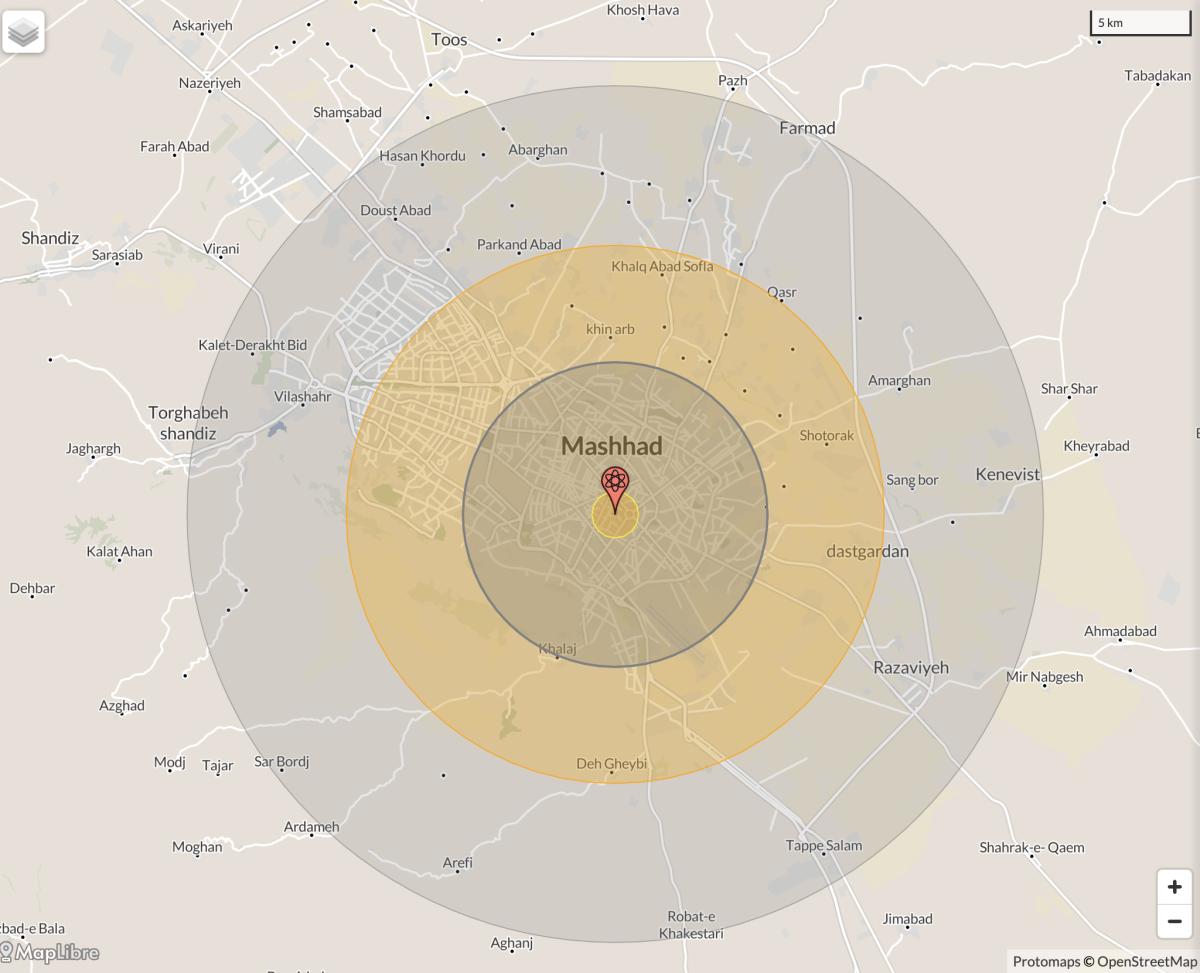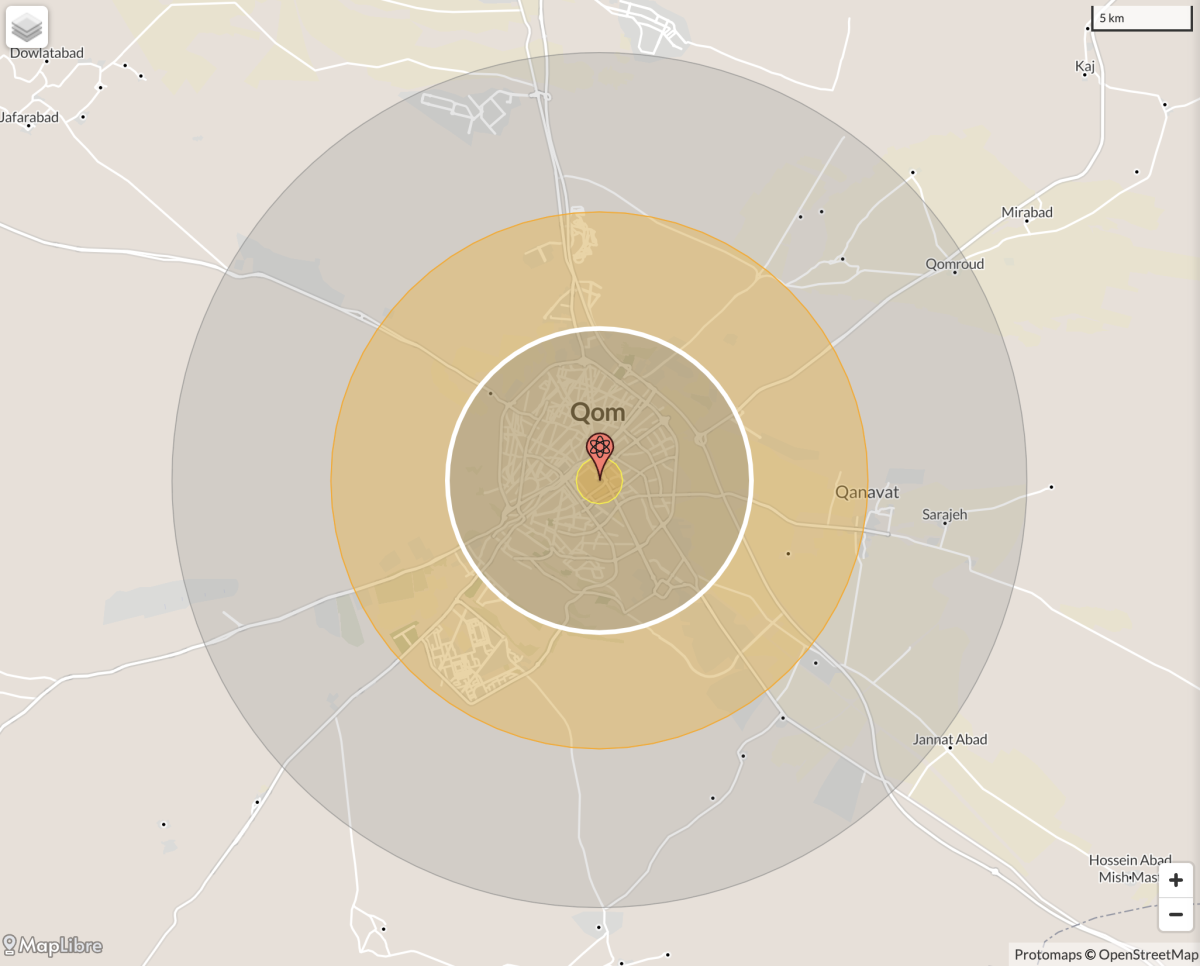A nuclear bomb map created using a simulation tool shows the devastating impact of a hypothetical U.S. nuclear strike on major Iranian cities amid an escalating crisis between Iran and Israel.
Using maps created by Alex Wellerstein, a professor and historian of nuclear technology, Newsweek assessed what the impact would be if a B-83, the largest weapon currently in the U.S. arsenal, was used to strike the capital city of Tehran, the populous urban centers of Mashhad and Isfahan, and the holy city of Qom.
The fireball radius indicated on the maps (inner yellow circle), represents everything that would be vaporized by intense heat rising to millions of degrees F. The more moderate blast damage radius (inner grey circle) would destroy residential buildings and probably cause widespread fires.
The third thermal radius circle would cause third-degree burns extended throughout the layers of skin, and the fourth light blast damage radius would cause glass windows to break, with the potential for many injuries.
While there is no indication that the U.S. is considering a nuclear strike on Iran, President Donald Trump has ignited tensions by warning that Washington will not allow Iran to develop atomic weapons.
He wrote on Truth Social on Monday: “Everyone should immediately evacuate Tehran!”
Trump added: “Iran should have signed the ‘deal’ I told them to sign. What a shame, and waste of human life. Simply stated, IRAN CAN NOT HAVE A NUCLEAR WEAPON. I said it over and over again.”
His warning followed a sharp escalation in hostilities between Israel and Iran. Last week, Israel launched a barrage of airstrikes against Iran targeting the country’s military and intelligence leadership, along with critical nuclear sites and scientists. Scores have been killed and wounded on both sides as a result of the conflict.
Israel launched surprise airstrikes on Iran on Friday, saying the assault was necessary to prevent its adversary from acquiring nuclear weapons. Iran has long denied Israel’s repeated accusation that it seeks nuclear weapons.
Trump may have named the wrong city in his evacuation warning on Monday, given that the Fordow nuclear facility—a nuclear enrichment plant buried under a mountain—is located near to the ancient religious city of Qom, not Tehran.
A targeted full-scale strike on the facility could have catastrophic consequences for the 1.2 million residents of Qom.
Newsweek has contacted the Pentagon and Iran’s Foreign Ministry via email for comment.
Tehran, Iran

NUKEMAP
In Tehran, an estimated 2,546,150 people would die and 3,772,020 would suffer injuries. In any given 24-hour period in the city, there are on average 9,461,407 people in the light (1 psi) blast range of the simulated detonation.
Mashhad, Iran

NUKEMAP
In Mashhad, an estimated 1,296,770 people would die and 1,131,380 would suffer injuries. In any given 24-hour period, there are on average 3,013,896 people in the light (1 psi) blast range of the simulated detonation.
Isfahan, Iran

NUKEMAP
In Isfahan, an estimated 791,080 people would die and 1,003,820 would suffer injuries. In any given 24-hour period, there are on average 2,596,335 people in the light (1 psi) blast range of the simulated detonation.
Qom, Iran

NUKEMAP
In Qom, an estimated 684,230 people would die and 339,670 would suffer injuries. In any given 24-hour period, there are on average 1,124,552 people in the light (1 psi) blast range of the simulated detonation.
Methods
Newsweek looked at the results of an airburst attack, more likely to be used in a strike on a city than a surface attack, according to the Bulletin of the Atomic Scientists.
What Happens Next
Trump has denied that he left the G7 summit early on Monday to work on an Israel-Iran ceasefire, but said he may send either Vice President JD Vance or U.S. Middle East envoy Steve Witkoff to meet with Iran.


